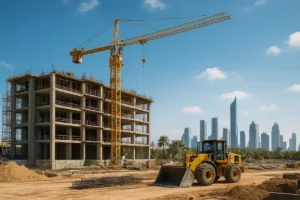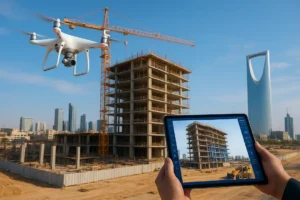Top Construction Technology Trends in Saudi Arabia
The world of construction in Saudi Arabia is changing fast. With the ambitious Saudi Vision 2030 guiding national priorities and hundreds of billions of dollars in mega-projects underway, the role of technology in construction cannot be ignored. In this article, we’ll dive into the top construction technology trends in Saudi Arabia that every builder, investor, project manager or stakeholder needs to know. From digital twins to modular construction and AI-driven job-site monitoring, you’ll see how construction in Saudi Arabia is undergoing a transformation.
Why Technology Matters in Saudi Arabia’s Construction Sector
Before we get into specific trends, it’s useful to set the scene for why these technologies are so critical in Saudi Arabia’s construction market.
A booming construction market
-
The construction industry in Saudi Arabia is projected to grow around 4 % in real terms in 2025.
-
Under Vision 2030 and the localization strategy, Saudi Arabia’s construction sector carries many mega-projects (e.g., NEOM, The Line) that demand high efficiency and technology.
Complexity, scale and sustainability
-
These projects are large, complex, multi-stakeholder and must meet sustainability goals. Digital tools help manage risk, coordinate teams and reduce waste.
-
In Saudi Arabia, supply chain maturity, collaboration across contractors, consultants and suppliers is still a challenge; digital adoption helps.
Therefore, the construction technology trends we cover are not just “nice to have” — they are becoming essential for Saudi Arabia’s construction industry to deliver on time, on budget and sustainably.
Top Construction Technology Trends in Saudi Arabia
Below are the key trends reshaping construction in Saudi Arabia. I’ll explain each trend, how it works, provide local examples, and the pros and cons.
1. Building Information Modelling (BIM) and Digital Twins
Definition & how it works:
-
BIM stands for Building Information Modelling — a process for creating and managing digital representations of physical and functional characteristics of a facility.
-
Digital twins are virtual replicas of real-world assets (buildings/sites) that can be used for simulation, monitoring and optimization.
Why it matters in Saudi Arabia’s construction:
-
In Saudi Arabia’s mega-projects the planning errors and rework risks are high. One study found digital planning (including 4D/5D BIM) can reduce planning errors by 20-30%.
-
Digital twins and BIM enable better coordination among teams, improved cost & schedule control, which is vital for construction in Saudi Arabia.
Examples:
-
On giga-projects in Saudi Arabia, BIM and 4D/5D scheduling tools are increasingly being mandated.
-
Digital twin systems are being used to monitor major developments and infrastructure.
Pros & Cons:
-
Pros: Better accuracy, fewer errors, improved collaboration, more transparency.
-
Cons: Requires training and culture change; initial investment; data management and interoperability challenges.
2. Modular Construction and Off-Site Prefabrication
Definition & how it works:
-
Modular construction means manufacturing building components off-site (in factories) then transporting and assembling them on-site.
-
Off-site prefabrication helps control quality, reduce waste, shorten timelines.
Why it matters in Saudi Arabia’s construction:
-
With tight schedules for large developments in Saudi Arabia, modular methods allow faster construction, less dependency on harsh on-site weather conditions (e.g., desert heat).
-
Reduces labour demands and improves productivity in construction in Saudi Arabia, where the workforce is under transformation.
Examples:
-
Several Saudi Arabia construction firms are adopting modular methods especially in hospitality, residential and worker-housing segments.
-
Green construction publications note modularity as a key trend in Saudi Arabia’s construction future.
Pros & Cons:
-
Pros: Faster build, lower waste, better quality control.
-
Cons: Up-front logistics challenges, transport of large modules, need for precise planning and coordination.
3. Internet of Things (IoT), Smart Sensors & Real-Time Monitoring
Definition & how it works:
-
IoT in construction means sensors on machines, materials or structures that collect data (temperature, humidity, vibration, load) and feed into systems for monitoring.
-
Enables real-time insights, preventive maintenance, safety monitoring.
Why it matters in Saudi Arabia’s construction:
-
For large sites in Saudi Arabia, especially with harsh environment (desert heat, remote locations), monitoring helps prevent delays or failures.
-
Enables predictive maintenance of equipment, tracking materials and improving safety on construction sites in Saudi Arabia.
Examples:
-
Research highlights that heavy construction in Saudi Arabia is exploring digital technologies (including IoT) to overcome sustainability and operational barriers.
-
Smart waste, smart infrastructure IoT systems are being piloted in Saudi Arabia’s built environment and city developments.
Pros & Cons:
-
Pros: Improved safety, fewer unplanned breakdowns, data-driven decision making.
-
Cons: Data security concerns, need for robust connectivity (which may be challenging in remote Saudi Arabia sites), initial sensor costs.
4. Artificial Intelligence (AI), Machine Learning & Automation
Definition & how it works:
-
AI and ML can analyse massive amounts of data from sensors, schedules, BIM models to predict issues (cost overruns, delays), optimise logistics, automate planning.
-
Automation includes robotics, autonomous vehicles, drones.
Why it matters in Saudi Arabia’s construction:
-
With ambitious timelines and budgets in Saudi Arabia, AI-driven insights are critical to keep projects on track.
-
Automation (such as drones, robotics) can help reduce human risk on sites and accelerate workflows in construction in Saudi Arabia.
Examples:
-
A blog on construction automation in Saudi Arabia lists AI-powered drones, cloud platforms, 3D printing among key trends.
-
The research paper on digital transformation in Saudi mega-projects lists AI-based scheduling and cloud systems.
Pros & Cons:
-
Pros: Increased productivity, fewer errors, improved forecasting, improved safety.
-
Cons: Requires data infrastructure, may face resistance from workforce, ethical/privacy issues, upfront costs.
5. 3D Printing, Robotics and Advanced Construction Machinery
Definition & how it works:
-
3D printing in construction involves printing components (often in concrete) layer by layer using specialised printers.
-
Robotics and smart equipment include machines guided by GPS, sensors, autonomous features.
Why it matters in Saudi Arabia’s construction:
-
Desert environment and need for faster construction in Saudi Arabia make off-site or automated methods appealing.
-
These technologies reduce waste, improve precision and speed in construction in Saudi Arabia.
Examples:
-
The “Construction Automation Trends in Saudi Arabia” article lists the rise of 3D printing in construction and AI-powered drones as key items.
-
On a local level, in Saudi Arabia the world’s first mosque built using 3D printing technology was completed in Jeddah.
Pros & Cons:
-
Pros: Significant waste reduction, faster construction time, improved design freedom.
-
Cons: Materials still under innovation, regulatory and code approval issues in Saudi Arabia, high initial investment.
6. Green Construction, Sustainability & Smart Cities
Definition & how it works:
-
Green construction means using sustainable materials, energy-efficient designs, renewable energy systems, and designs that reduce environmental impact.
-
Smart cities integrate digital infrastructure, sensors, data analytics to optimise urban operations, resource use.
Why it matters in Saudi Arabia’s construction:
-
Saudi Arabia has committed to environmental targets (e.g., the Saudi Green Initiative) and large urban developments that must meet sustainability goals.
-
In construction in Saudi Arabia the pressure to build not just large, but sustainable, means technology is key.
Examples:
-
A study on sustainability barriers in heavy construction and role of digital tech in Saudi Arabia.
-
Smart city market in Middle East (including Saudi Arabia) has high projected growth (CAGR ~9.86% 2023-2028).
Pros & Cons:
-
Pros: Long-term cost savings, environmental compliance, improved reputation, resilience.
-
Cons: Higher upfront cost, need for skilled labour, potential trade-offs in speed of delivery for eco-friendly materials or methods.
Challenges & Considerations for Construction Technology in Saudi Arabia
While the opportunities are vast, it’s important to understand the major challenges:
-
High upfront investment: Many technologies require significant capital before benefits accrue in construction in Saudi Arabia.
-
Skilled labour shortage: The workforce needs training and digital cultural shift, especially in Saudi Arabia’s construction firms.
-
Data and interoperability issues: Platforms may not integrate easily; BIM, IoT, AI systems need standardisation.
-
Regulatory/standards gap: Local building codes, certification, modular building approvals in Saudi Arabia may lag behind technology.
-
Supply chain complexity: In Saudi Arabia, logistics, imports, materials sourcing pose additional risk; digital supply chain solutions are required.
-
Cybersecurity and data privacy: With IoT, cloud platforms and AI, data breach risks are higher; especially relevant in Saudi Arabia’s large infrastructure sites.
-
Cultural change & stakeholder buy-in: Contractors, workers, stakeholders in Saudi Arabia must view technology as enabler, not threat to jobs.
Why These Trends Matter for You
If you are involved in construction projects, development or investment in Saudi Arabia, paying attention to these construction technology trends is vital. They can lead to:
-
shorter project timelines
-
better cost control
-
improved safety and quality
-
alignment with national priorities (Vision 2030)
-
competitive advantage in the Saudi market
Whether you are a contractor bidding on a project in Riyadh, Jeddah or NEOM, an investor assessing risk, or a consultant advising clients, understanding how construction technology is evolving in Saudi Arabia gives you an edge.
Conclusion
In summary, construction in Saudi Arabia is entering a new era. Driven by mega-projects under Vision 2030 and the demand for speed, scale and sustainability, technology is no longer optional—it’s essential. From BIM and digital twins, to modular construction, IoT, AI and green methods, the top construction technology trends in Saudi Arabia are reshaping how buildings and infrastructure are designed, built and operated.
To succeed, stakeholders must adopt these technologies, invest in skills, collaborate across the value chain and measure results. While challenges remain, the potential for improved efficiency, cost savings and sustainable outcomes is vast. If you are working in the Saudi Arabia construction sector, now is the time to embrace these trends or risk being left behind.



